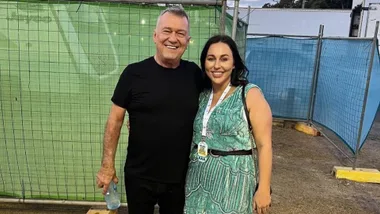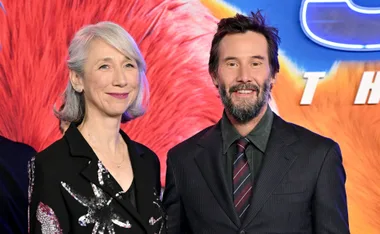Today Prince Harry travelled to Marquarie University Clinic to meet with a British soldier who lost both legs in Afghanistan in 2001.
Lieutenant Ali Spearing is having prosthetic legs fitted and being treated by one of the best surgeons in the world, Dr Munjed Al Muderis.
The Weekly spoke Al Muderis, who is different to most surgeons, growing up in war torn Iraq and arriving in Australia as a refugee in ….
Clair Weaver investigates.
HE’S a world-leading surgeon who drives a Porsche, wears Italian designer clothes and lives in a luxury waterfront home overlooking the Sydney Harbour Bridge.
Patients come from all over the world to go under his knife, as he transforms lives with artificial bones and robotic limbs.
He leads research, lectures and travels regularly to Europe to stay on top of his game. Confident, driven and articulate, Dr Munjed Al Muderis has all the trappings of Australia’s medical elite.
Yet, 14 years ago, it was a very different picture. Soaking wet and exhausted, he was hauled ashore by police as a refugee, with little more than the clothes on his back. He had fled his native Iraq when Saddam Hussein’s henchmen ordered him to carry out the most brutal of acts: cutting the ears off soldiers who had deserted.
Transferred to a violence-wracked detention centre in the WA outback, Dr Al Muderis was known for the next 10 months only by his number: “982”.
Today, his name has global reach. He’s one of only a handful of orthopaedic surgeons in the world performing osseointegration: a radical procedure in which a metallic rod is implanted directly into an amputee’s thigh bone, creating a protruding artificial bone that connects directly onto a robotic limb.
The resulting bionic leg – in which bone and muscle grow around the upper part of the rod and a system of hydraulics, sensors and a lithium battery drive the lower limb – allows patients almost the same range of motion and movement as an able-bodied person.
Because the leg is connected to the skeleton, patients often remark they can “feel the ground” under their artificial foot for the first time. It bears little resemblance to traditional prosthetics, which can be painful and cumbersome.
“They go from being a disabled person to someone who is special – with something extra,” Dr Al Muderis says. “We’re on the verge of changing the future for amputee management worldwide.”
Over the past three years, he has performed more of this type of surgery than anyone else, pushing into world-first territory with the complexity of his cases.
The British military is sending a double- amputee halfway around the world to his clinic as a trial, with a view to referring fighters who have lost legs in combat. “I’m very honoured,” Dr Al Muderis says.
While there’s irony in an Iraqi-born surgeon rehabilitating troops from nations that occupied his country, the 41-year-old feels a strong desire to give back.
“[Losing a limb] is an unfortunate thing to happen to anyone,” he says, “but especially soldiers who are trying to help out in places like Iraq and Afghanistan.”
His sense of obligation doesn’t end there: Dr Al Muderis is also a squadron leader in the Australian Air Force Reserves and hopes his surgical skills can be used in service to this country’s injured defence personnel – “it’s the reason I joined.”
So how did this one-time boat person get to where he is today?
At Curtin Detention Centre in WA’s Kimberley, he met then Immigration Minister Philip Ruddock during an official inspection of the facility.
“We were having a conversation and I said that I was a doctor,” recalls Dr Al Muderis. “He said, ‘You will probably never prove your qualification [in Australia]’.” Yet this was no deterrent.
“If you want something and you are determined, anything is possible. Australia is the land of opportunity,” he says.
So what would he say if he were reunited with Mr Ruddock today?
“I’d be interested to meet him – his opinions still carry weight,” muses Dr Al Muderis. “Not to say, ‘You’re wrong’, but to say, ‘Hey mate, let’s talk about it.’”
One of the reasons behind his meteoric rise is his extraordinary work ethic. Since his release, he has accepted placements from Mildura and Melbourne to Bendigo, Wollongong and Canberra – while never giving up on his dream of undertaking robotic surgery.
In 2008, he obtained his surgical fellowship in orthopaedics, before travelling to Germany to learn the osseointegration procedure.
During a stint in NSW’s Lismore, he met a beautiful Russian medical trainee, Irina, now his 36-year-old wife and a GP. The couple has a four-year-old daughter, Sophia, along with his sons, Adam, 11, and Dean, nine, from a previous relationship. The boys are following in their father’s footsteps by excelling at school, while their younger sister is as equally enraptured by videos of her dad’s surgery as playing with her beloved Barbie dolls.
Even with increasing commitments elsewhere in his life, Dr Al Muderis’ capacity for work shows no sign of abating. It’s not uncommon for him
to be operating from early morning to midnight during the week, fuelled by up to two litres of Coca-Cola a day. Most surgeons have one daily theatre list; he often has two on the go.
It’s clear his job is far more than a way to pay the bills. A curious child, he loved to construct things with his Meccano set. Yet it was seeing the blockbuster Arnold Schwarzenegger movie, The Terminator, as a teen that captured his imagination.
“I knew then I wanted to become a surgeon,” he recalls. “The ultimate dream was to make a half-human, half-robot.”

Although forced to build a new life from scratch, Dr Al Muderis comes from a privileged background in Iraq.
A descendant of Iraqi royalty, his uncle was an ex-prime minister and his late father, Abdul Razzak Al Muderis, was head of the country’s Supreme Court.
Yet medicine was also in his blood. After graduating from university, he was working as an intern at Baghdad Hospital when the brutality of Saddam Hussein’s regime pierced the comfortable bubble of his everyday life. He had been mulling over plans for dinner when three busloads of soldiers suddenly pulled up outside.
“[Military commanders] came in and ordered us to surgically remove the ears of about 100 army deserters,” he recalls.
The head of his department challenged the order, citing the universal medical pledge “to do no harm”.
“So the commanders gathered everyone in the carpark and put a bullet through his head. Then they said, ‘If you share his views, please come forward.’”
In horror, Dr Al Muderis hid in a female toilet cubicle for five hours. Heart pounding as soldiers stalked the corridors in search of missing doctors, he made
a run for it during a lull. Sprinting into the outer suburbs, he knew he could never go home again.
His fears were warranted: intelligence officers came looking for him, questioning his mother as he fled by bus to Jordan. In the capital, Amman, the young doctor contacted an aunt, who helped him get to Malaysia, via Abu Dhabi.
Here his destiny fell into the laps of people smugglers. In Kuala Lumpur, he met a blond man who demanded $1500 upfront to get him to Indonesia. Handing over the money, Dr Al Muderis asked, “How can I trust you?” The response: “What choice do you have?”
In Jakarta, he was fast-tracked onto a boat when it was discovered he was a doctor. Until Dr Al Muderis stepped onto the flimsy wooden vessel – soon to be crammed with about 160 passengers rather than the 50 he’d been advised of – he had no idea where he was heading. When the Indonesian skipper abandoned ship as they reached international waters, climbing onto a frigate alongside, he told them to stay on a straight course to reach Christmas Island in 36 hours.
The next part of the journey was a nightmarish blur of treating sick passengers amid violently churning seas on a deck so overcrowded that people were unable to sit down. Arriving at Christmas Island on November 8, 1999, police officers escorted them to a makeshift camp and gave them towels to dry off. A small block of toilets was quickly overwhelmed by a putrefying mess left by new arrivals unfamiliar with Western toilets. Five days later, the group was flown to Curtin.
Conditions were grim: detainees lived in tents with no change of clothing or protection from blazing heat and poisonous snakes. Dr Al Muderis saw detainees being beaten by guards and violence and riots often erupted, fuelled by frustration over delays in processing.
Back in Baghdad, however, his mother, Kamila Al Turck, was about to get the best phone call of her life.
After months of not knowing the fate of her only child, the phone rang. Dr Al Muderis had been offered use of a mobile phone by a police officer while helping out as a translator. “I said, ‘I’m in Australia and I’m safe’ … All I could hear was crying.”
Mrs Al Turck now lives comfortably in a nursing home in Sydney, fully financially supported by her son.
While some surgeons have a reputation for being aloof and arrogant, it’s clear Dr Al Muderis is adored by his patients.
“Munjed is so passionate and positive about this surgery and he really cares,” says patient Nicola Carslaw, a mother of two from Perth, WA.
“I send him messages and photos, and he replies personally. His team is also amazing and you can see how much they think of him.”
Aside from robotics, the bulk of Dr Al Muderis’ work is regular hip and knee surgery – albeit using the most modern techniques. Yet his maverick attitude doesn’t always make him popular.
At a conference shortly after his first osseointegration, he met a couple of former bosses. One congratulated him; the other told him he belonged in Long Bay jail for performing such radical surgery.
Given Dr Al Muderis spent three months in maximum security at Broome for allegedly inciting unrest after smuggling cameras into detention to expose the conditions, the criticism was stinging even in jest.
“[Osseointegration] is groundbreaking, but it’s proven now,” he says. In any case, the first priority is his patients. And for Dr Al Muderis – who knows what it’s like to be treated like a number – the secret to his bedside manner is simple.
“I treat them as human beings.”
And when it comes to Asylum seeker policies, Dr Al Muderis, who understands the issue more comprehensively than most, thinks neither of the major political parties has provided a real solution.
He points out that there is no “queue” and little choice in the chaotic world of refugees. Nor is there the luxury of time.
“If you can wait three years for processing, then you are not a genuine refugee.”
Make no mistake: he believes all asylum seekers should be screened to ensure they are genuine and prevent terrorists entering the country. “The process definitely needs to be done, but not in the way it is now,” he says. “And looking at asylum seekers as scumbags is wrong. They’re a slice of the community, like any other, in which there are the good, bad and ugly.”
He is unequivocal in his belief that children should not be incarcerated: the mental and emotional toll is too great. And he has some insight after teaching English to kids at Curtin.
“They will be traumatised for the rest of their lives,” he says. “Even today I don’t like the colour green, it puts me on edge: all the barbed wire and fences were that colour.”
Rather than rendering asylum seekers helpless, insular and dependent on state handouts by locking them away, he suggests electronically tagging them and sending them to farms.
“They’d be happy to pick fruit and learn the language and culture,” he says. “They could report to a police station or stay in detention at night.”
Meanwhile, he says, there’s an onus on asylum seekers to integrate and accept Australian values.
Today, Dr Al Muderis says he feels “extremely lucky” to live in Australia, a country in which he now feels a profound sense of loyalty, pride and belonging. On the other hand, one might argue Australia is pretty lucky to have him.











